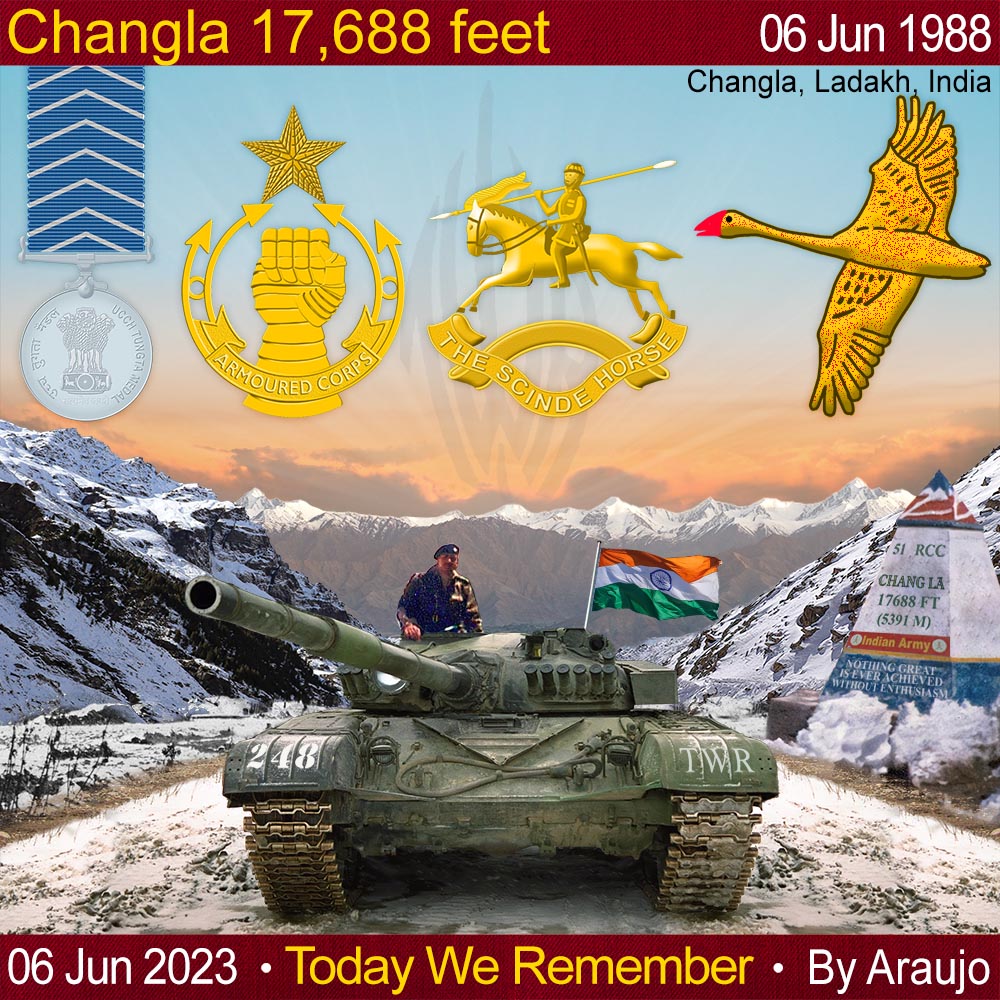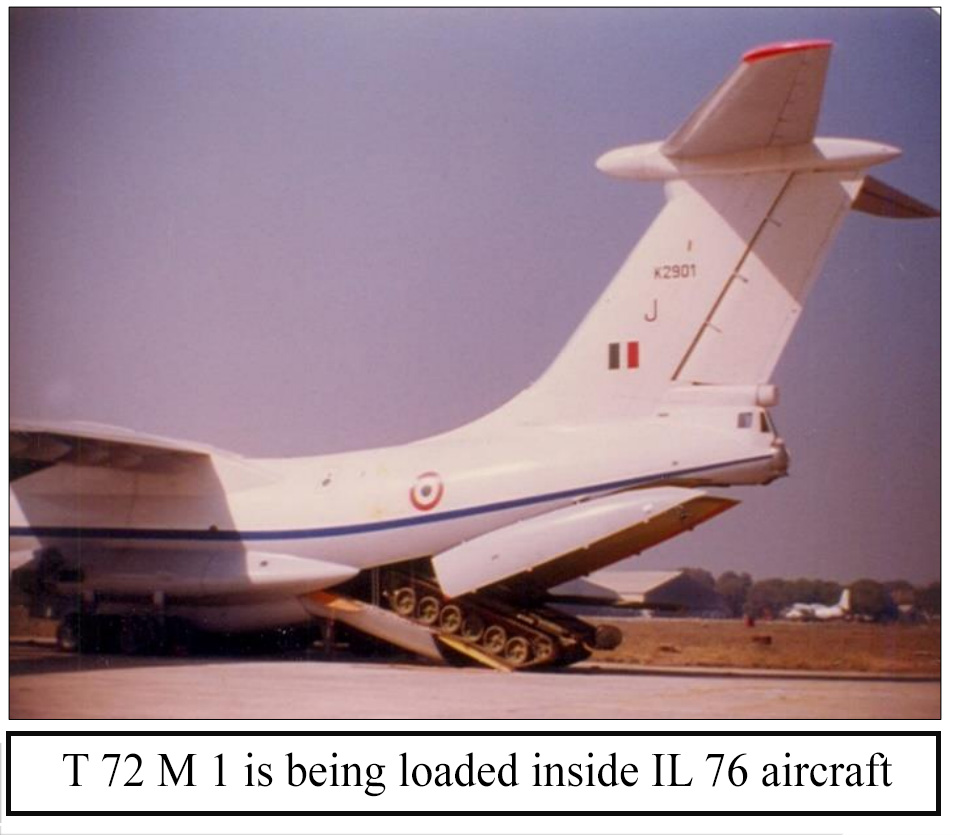Indian Army’s 14 ‘Scinde’ Horse led by Lt Col Rajendra Singh, SM fields T-72 Main Battle Tank in Changla, Ladakh at an Altitude of 17,688 feet.

MOUNTAIN CAVALRY
BY
Lt Col RAJENDRA SINGH, SM (Retired)
Introduction
No, the center heading above is not a misprint but a fact. A part of Indian Armoured Corps history which can be literally looked up upon as an extraordinary feat both by men and machines. 91 Independent Reconnaissance Squadron was the first squadron to be inducted into high altitude area ( Leh ) from 21 January to 08 February 1988.
The Dawning of Truth
After Brass Tacks ‘IV’ as part of 1 Armoured Division we heard rumours that our squadron is earmarked to be inducted into high altitude area. We all took it as yet another ‘Langar gup’ as we could not imagine an armoured squadron equipped with medium tanks (new T72 M1’s) on the roof of the world.
When the truth dawned on us in the form of executive orders from Army Headquarters- we started giving topmost priority to this move. The effects of high altitude on personnel and equipment were explained to all ranks. We found out what exactly extreme cold climate clothing comprised of. The effect of extreme cold climate (upto – 40 deg C) on tanks and ‘B’ vehicles and relevant chapters from the tank manual and EMERs were studied in detail. One thing was foremost in our minds ie; we shouldn’t goof up any thing as being part of the mighty ‘ Scinde Horse’ we had to live up to our name. Maj AK Singh, 7 Cav, Army Cdr, Southern Comd ( Later Lt Governor Andaman & Nicobar Islands & Pondicherry ) and me were detailed to liaise with 3 Inf Div at Leh, both of us cleared up all the doubts we had to ensure a flawless induction. This proved very useful to plan my squadron’s induction as we were the first to go. A trial tank of 68 Armd Regt was inducted in two parts and was not functioning too well. The EME workshop while joining the hull and the turret, on starting the tank, the driver’s panel short circuited. This was an important lesson for me and I decided I will try to bring up my tanks in one piece.
Sequence of Events
Col PPS Dhillon, Commandant, the Scinde Horse and me, were summoned to the powers that be at Army Headquarters. After detailed briefing the move requirements were crystallized. Our old mounts the grand old T-55 (Up gunned) tanks were to be shed off to various Armoured Regiments. The new ‘iron horses’ the T-72 M1’s were to be collected from Bombay.
After a capsule conversion course in the Scinde Horse the squadron personnel proceeded to Ahmednagar for collection of tanks and another quick conversion training. Lt SB Thota did a commendable job here.
The tanks after collection were brought on a special train to Agra for the air lift on the mighty jet – IL-76 (Gajraj).
At Agra the EME team from the Armoured Division was waiting to break up each new tank in two parts ie: the hull and the turret. After witnessing what had happened to the trial tank earlier I did not want to go up with crippled tanks. I spoke to an experienced Warrant Officer (AF) who told me that the all-up weight of an IL-76 is 190 tons, to increase the payload, we can reduce the fuel and refuel at LEH. I spoke with Wing Co Bewoor (Gen Bewoor’s son) who was commanding this AF Squadron. He was very positive as he would have saved 15 sorties and I could take my new tanks up in one piece. He told me to reduce my tank weight to 40 tons. Since the combat weight of a T-72 M1 is 43.300 tons so I removed the outer fitments like ‘balli’, tarpaulin, camouflage net, outer fuel barrels, deep fording equipment etc. I also reduced the fuel and kept only 400 litres to ensure we do not have an airlock. Our proposal was accepted by AHQs and this is how my squadron was the first to take up a full medium tank in one sortie.
The first tank to be loaded took three hours as the track adjustment of one side was more. Once this was corrected we cut down the timings ranging between 40 minutes to 1 hr. Once inside the IL- 76 the gap between the outer side of tank tracks and the inner wall of the aircraft was approximately 5 to 6 cms per side. The precision driving required for such a task, can well be imagined.
Meanwhile under supervision of 1 Armoured Division the advance party was dispatched from Chandigarh on an AN-12 aircraft a new experience for Armoured Corps personnel. The main body was flown in next under Capt Arun Pandey, this involved a bit of planning as only 25 tonnes of load were authorised. Since it was winters, the changes in temperatures of Chandigarh and Leh was 10 deg C to (minus) 30 deg C. The new ECC clothing issued to us was a saving grace; slowly but surely we got used to Bukharis and peculiar sounding names of villages rhyming with ‘ Ping Pong ’. In the day time with the intense ultra violet rays of the sun the weather was super but nights were bone chilling.
Trials
The squadron was involved in a lot of trials/ recce in the Div Sector to evaluate its effective employment. Two tanks of this squadron managed to get across a pass as high as 17,688 feet ASL. This is the highest pass ever to be negotiated by a medium tank. After this feat we looked upon this invincible tank with fortified pride. During this move the tanks had to roll across a kutcha track which barely catered for the width of the tank. The bends were so sudden and steep that the drivers had to be alert every second. Across the pass, on the downgrade, due to ice on the track, the tank skidded but the driver cut stick and banged into the mountain side to avoid rolling down, I was on this tank. Here onwards we moved across this slippery patch at a snail’s pace. This feat could well be recorded in the Guinness Book of World Records.
Standard Operating Procedure and Op Recce Summer & Winters
An SOP for operation of tanks in high altitude has also been formulated. CO 1 Mech ( Lt Gen Panag ) and me carried out a summer and winter recce of our OP area and submitted a 70 page recce report which will benefit those who follow us. I was lucky to carry out recce of the Partapur Sector and upto base camp.
Fire Power Demonstration / Combat Team in Quick Attack:-
Both 91 Independent Reconnaissance Squadron and 1 Independent Armoured Squadron (the second squadron to be inducted a month later) alongwith 1 Mechanised Infantry gave an impressive fire power demonstration. While zeroing our tanks, due to rarified air the tank projectiles where hitting 4 feet up, we corrected it accordingly. This culminated by giving a demonstration of a Combat team in quick attack.
Conclusion
It was in 1948 that the light tanks of 7th Light Cavalry were first employed in the mountains in Zojila Pass by Capt now Col SDS Jamwal ( Retd ) my Uncle, ( I am the 2nd Jamwal to cross a higher pass ie; 17,688 ft). The very presence of armour at such an altitude (11.500 ft) Zojila Pass, demoralized the enemy and raised the morale of own troops resulting in a decisive victory.
With the best armour the country has to offer and operating between 14,000 to 17,688’, I’m sure, should the need arise, any potential enemy will be given a befitting reply. The morale of the Scinde Horse men is so high after this feat that both in defensive and offensive operations the Regimental motto ‘MAN DIES BUT THE REGIMENT LIVES’ will fire our spirits even more.
Thanks to our trial, we became the first Squadron to land our medium tanks in Leh and cross the highest pass. Today there is an Armoured Brigade there, based on our report.

